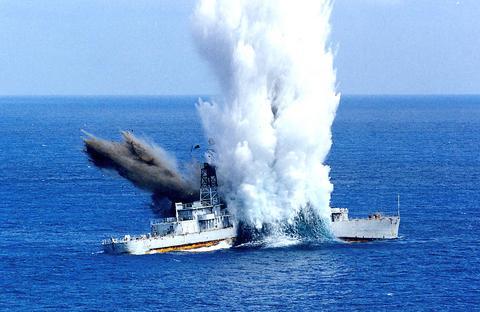The navy regained its self-confidence yesterday after a successful torpedo test.
The success came after the navy failed to hit a target in the Sept. 4 Hankuang No. 19 exercise.
The first of two torpedoes fired yesterday developed similar problems as the one in the Hankuang, or Han Glory, exercise and failed to hit its target.

PHOTO: REUTERS
But a second try yesterday worked, marking the first success the navy has had in two decades in firing a live torpedo from a submarine.
The torpedo tests were held at a beach in Chialutang, Pingtung County.
The result cheered up navy commander-in-chief Admiral Miao Yung-ching (
"It has helped us regain self-confidence," Miao said in a brief speech after the torpedo tests. "It will also make the public have confidence in us again."
"Despite the success, we will seek to find out what caused the other tests to fail to ensure that no mistakes of the same kind are made again," Miao said.
Yesterday's tests were intended to make up for the navy's failures in the Hankuang exercise, which included a live submarine-launched torpedo and a land-based Chaparral air defense missile. The Chaparral is used by the marine corps.
It was President Chen Shui-bian's (陳水扁) idea that the navy and other armed services launch more tests of weapons systems that developed problems in the Hankuang exercise until they were able to hit the target without fault.
Torpedoes were not the only weapons put to the test in yesterday's live-fire drills.
The Mica air-to-air missile and the Chaparral missile were also tested. Both hit their targets.
The Mica was not launched during the Hankuang exercise because its intended target was mistakenly shot down by a Standard SM-1 missile fired from a Chengkung-class frigate.
The Chaparral was off the mark in the Hankuang exercise.
After the Mica and Chaparral passed the tests, the navy's heavyweight SUT torpedo became the center of attention. The navy had been preparing for the SUT test for several weeks. The navy had fired another live torpedo in a rehearsal on Oct. 8. The test was successful, but could not be officially counted.
The training drills yesterday were supposed to have been completed by noon, but were extended after the first SUT torpedo went out of control.
Initial probes by the navy showed that the wire guiding the torpedo broke during the homing process, a situation similar to what happened in the Hankuang exercise.
The navy said the torpedo sank to the bottom of the sea about 53 minutes after it lost contact with the submarine.
The sea where the torpedo test was held was up to 1,571m deep, the navy said.
"After its batteries run out, the torpedo will sink to the seabed," it said.
A second torpedo test took place at 2:20pm. Six minutes later, the torpedo hit a decommissioned Yang-class destroyer, about 60 nautical miles off the coast.

US climber Alex Honnold is to attempt to scale Taipei 101 without a rope and harness in a live Netflix special on Jan. 24, the streaming platform announced on Wednesday. Accounting for the time difference, the two-hour broadcast of Honnold’s climb, called Skyscraper Live, is to air on Jan. 23 in the US, Netflix said in a statement. Honnold, 40, was the first person ever to free solo climb the 900m El Capitan rock formation in Yosemite National Park — a feat that was recorded and later made into the 2018 documentary film Free Solo. Netflix previewed Skyscraper Live in October, after videos

Starting on Jan. 1, YouBike riders must have insurance to use the service, and a six-month trial of NT$5 coupons under certain conditions would be implemented to balance bike shortages, a joint statement from transportation departments across Taipei, New Taipei City and Taoyuan announced yesterday. The rental bike system operator said that coupons would be offered to riders to rent bikes from full stations, for riders who take out an electric-assisted bike from a full station, and for riders who return a bike to an empty station. All riders with YouBike accounts are automatically eligible for the program, and each membership account

A classified Pentagon-produced, multiyear assessment — the Overmatch brief — highlighted unreported Chinese capabilities to destroy US military assets and identified US supply chain choke points, painting a disturbing picture of waning US military might, a New York Times editorial published on Monday said. US Secretary of Defense Pete Hegseth’s comments in November last year that “we lose every time” in Pentagon-conducted war games pitting the US against China further highlighted the uncertainty about the US’ capability to intervene in the event of a Chinese invasion of Taiwan. “It shows the Pentagon’s overreliance on expensive, vulnerable weapons as adversaries field cheap, technologically

NUMBERS IMBALANCE: More than 4 million Taiwanese have visited China this year, while only about half a million Chinese have visited here Beijing has yet to respond to Taiwan’s requests for negotiation over matters related to the recovery of cross-strait tourism, the Tourism Administration said yesterday. Taiwan’s tourism authority issued the statement after Chinese-language daily the China Times reported yesterday that the government’s policy of banning group tours to China does not stop Taiwanese from visiting the country. As of October, more than 4.2 million had traveled to China this year, exceeding last year. Beijing estimated the number of Taiwanese tourists in China could reach 4.5 million this year. By contrast, only 500,000 Chinese tourists are expected in Taiwan, the report said. The report